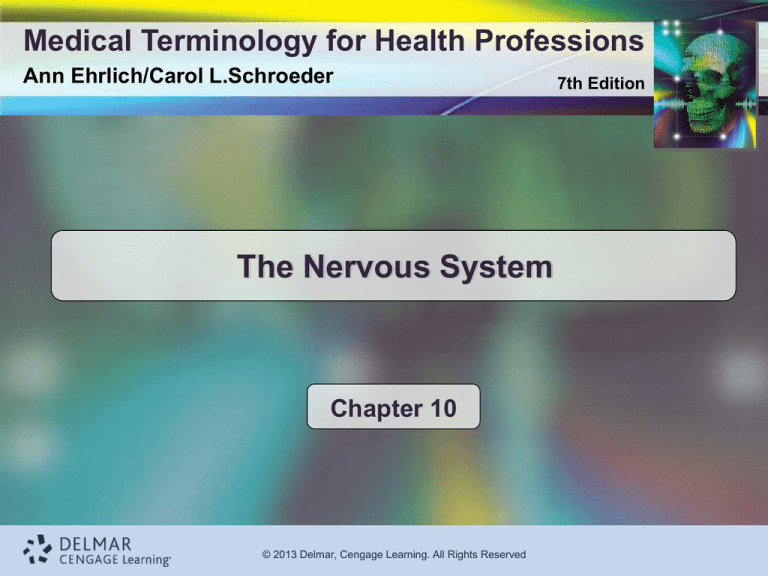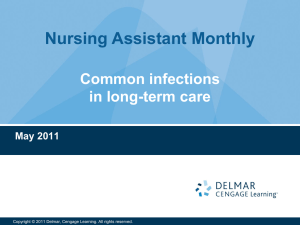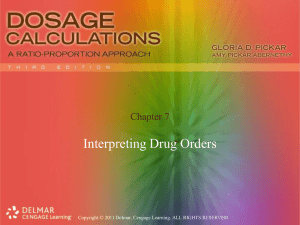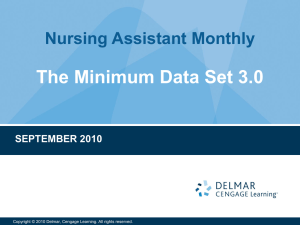
Medical Terminology for Health Professions
Ann Ehrlich/Carol L.Schroeder
The Nervous System
Chapter 10
© 2013 Delmar, Cengage Learning. All Rights Reserved
7th Edition
Overview of Structures, Combining Forms,
and Functions of the Nervous System
© 2013 Delmar, Cengage Learning. All Rights Reserved
Divisions of Nervous System
• Central nervous system – includes brain and
spinal cord
• Peripheral nervous system – includes 12 pairs
of cranial nerves and 31 pairs of peripheral
spinal nerves
(continues)
© 2013 Delmar, Cengage Learning. All Rights Reserved
Divisions of Nervous System
© 2013 Delmar, Cengage Learning. All Rights Reserved
The Neurons
•
•
•
•
•
Basic cells of nervous system
Carry nerve impulses throughout body
Afferent neurons
Connecting neurons
Efferent neurons
(continues)
© 2013 Delmar, Cengage Learning. All Rights Reserved
The Neurons
© 2013 Delmar, Cengage Learning. All Rights Reserved
Brain
• Primary Function
– Coordinates all activities of the body by receiving
and transmitting messages throughout the body
• Related Word Parts (Combining Forms)
– encephal/o
© 2013 Delmar, Cengage Learning. All Rights Reserved
Major Parts of the Brain
•
•
•
•
•
Cerebrum
Thalamus
Hypothalamus
Cerebellum
Brainstem
(continues)
© 2013 Delmar, Cengage Learning. All Rights Reserved
Major Parts of the Brain
© 2013 Delmar, Cengage Learning. All Rights Reserved
Cerebrum
• Cerebrum – largest and uppermost portion
of brain
– divided into right and left hemispheres
– hemispheres subdivided to create pairs of
cerebral lobes
© 2013 Delmar, Cengage Learning. All Rights Reserved
Cerebral Hemispheres
© 2013 Delmar, Cengage Learning. All Rights Reserved
Cerebral Lobes
• Cerebral lobes
– frontal lobe: controls skilled motor functions,
memory, behavior
– pariental lobe: receives and interprets nerve
impulses from sensory receptors in tongue,
skin, muscles
– occipital lobe: controls eyesight
– temporal lobe: controls hearing and smell, and
ability to create, store, and access new information
© 2013 Delmar, Cengage Learning. All Rights Reserved
Cerebral Lobes
© 2013 Delmar, Cengage Learning. All Rights Reserved
Spinal Cord
• Primary Function
– Transmits nerve impulses between the brain,
limbs, and lower part of the body
• Related Word Parts (Combining Forms)
– myel/o
Note: Myel/o also means bone marrow.
© 2013 Delmar, Cengage Learning. All Rights Reserved
Nerves
• Primary Function
– Receive and transmit messages to and from all
parts of the body
• Related Word Parts (Combining Forms)
– neur/i, neur/o
© 2013 Delmar, Cengage Learning. All Rights Reserved
Cranial Nerves
© 2013 Delmar, Cengage Learning. All Rights Reserved
Peripheral Spinal Nerves
© 2013 Delmar, Cengage Learning. All Rights Reserved
Autonomic Nerves System
© 2013 Delmar, Cengage Learning. All Rights Reserved
Sensory Organs and Receptors
• Primary Functions
– Receive external stimulation and transmit these
stimuli to the sensory neurons
Eyes (sight)
Ears (hearing)
Nose (smell)
Skin (touch)
Tongue (taste)
© 2013 Delmar, Cengage Learning. All Rights Reserved
Key Word Parts and Definitions
• caus/o
– burning, burn
• cerebr/o
– cerebrum, brain
• concuss/o
– shaken together, violently agitated
• contus/o
– bruise
(continues)
© 2013 Delmar, Cengage Learning. All Rights Reserved
Key Word Parts and Definitions
• encephal/o
– brain
• -esthesia
– sensation, feeling
• esthet/o
– feeling, nervous sensation, sense of perception
• -graphy
– the process of producing a picture or record
(continues)
© 2013 Delmar, Cengage Learning. All Rights Reserved
Key Word Parts and Definitions
• mening/o
– membranes, meninges
• myel/o
– spinal cord, bone marrow
• neur/i, neur/o
– nerve, nerve tissue
• phobia
– abnormal fear
(continues)
© 2013 Delmar, Cengage Learning. All Rights Reserved
Key Word Parts and Definitions
• psych/o
– mind
• radicul/o
– root or nerve root
• tropic
– having an affinity for
© 2013 Delmar, Cengage Learning. All Rights Reserved
Parkinson’s Disease
Click Here to play Parkinson’s
Disease animation
© 2013 Delmar, Cengage Learning. All Rights Reserved
Questions
© 2013 Delmar, Cengage Learning. All Rights Reserved
Question
The most sensitive cluster of nerves is at the
front of the brain.
True or False?
© 2013 Delmar, Cengage Learning. All Rights Reserved
Answer
False. The most sensitive cluster of nerves is at
the base of the spine.
© 2013 Delmar, Cengage Learning. All Rights Reserved
Question
The human brain is 80%–85% water.
True or False?
© 2013 Delmar, Cengage Learning. All Rights Reserved
Answer
True
© 2013 Delmar, Cengage Learning. All Rights Reserved
Question
How much of the oxygen used by the human
body is utilized by the brain?
a. over 10%
b. over 25%
c. over 50%
© 2013 Delmar, Cengage Learning. All Rights Reserved
Answer
b. Over 25%
© 2013 Delmar, Cengage Learning. All Rights Reserved
Question
The human body transmits nerve impulses at
about 300 feet a second.
True or False?
© 2013 Delmar, Cengage Learning. All Rights Reserved
Answer
True
© 2013 Delmar, Cengage Learning. All Rights Reserved
Answers to Learning Exercises
© 2013 Delmar, Cengage Learning. All Rights Reserved
Chapter 10 Answers
Matching Word Parts 1
10.1. esthet/o
10.2. encephal/o
10.3. contus/o
10.4. psych/o
10.5. concuss/o
Matching Word Parts 2
10.6. mening/o
10.7. -graphy
10.8. -esthesia
10.9. myel/o
10.10. radicul/o
© 2013 Delmar, Cengage Learning. All Rights Reserved
Chapter 10 Answers
Matching Word Parts 3
10.11. phobia
10.12. caus/o
10.13. cerebr/o
10.14. neur/o
10.15. -tropic
Definitions
10.16. synapse
10.17. myelin sheath
10.18. dendrites
10.19. pia mater
10.20. hypothalamus
10.21. sympathetic
10.22. plexus
10.23. peripheral
10.24. thalamus
10.25. efferent
© 2013 Delmar, Cengage Learning. All Rights Reserved
Chapter 10 Answers
Matching Structures
10.26. brainstem
10.27. hypothalamus
10.28. cerebellum
10.29. medulla oblongata
10.30. cerebrum
Which Word?
10.31. anesthesiologist
10.32. coma
10.33. anxiolytic
10.34. hallucination
10.35. acrophobia
© 2013 Delmar, Cengage Learning. All Rights Reserved
Chapter 10 Answers
Spelling Counts
10.36. migraine
10.37. Alzheimer’s
10.38. anesthetic
10.39. epilepsy
10.40. sciatica
Abbreviation Identification
10.41. cerebral palsy
10.42. cerebrospinal fluid
10.43. obsessive-compulsive
disorder
10.44. post-traumatic stress
disorder
10.45. transient ischemic
attack
© 2013 Delmar, Cengage Learning. All Rights Reserved
Chapter 10 Answers
Term Selection
10.46. delirium
10.47. myelitis
10.48. claustrophobia
10.49. trigeminal neuralgia
10.50. dyslexia
Sentence Completion
10.51. cerebral contusion
10.52. anxiety disorders
10.53. dysthymia
10.54. factitious
10.55. antipsychotic
© 2013 Delmar, Cengage Learning. All Rights Reserved
Chapter 10 Answers
Word Surgery
10.56. an-, esthet, -ic
10.57. somn, ambul, -ism
10.58. electr/o, encephal/o, -graphy
10.59. par-, -esthesia
10.60. poli/o, myel, -itis
True/False
10.61. True
10.62. True
10.63. False
10.64. False
10.65. True
© 2013 Delmar, Cengage Learning. All Rights Reserved
Chapter 10 Answers
Clinical Conditions
10.66. bipolar
10.67. concussion
10.68. transient ischemic
10.69. thalamotomy
10.70. multiple sclerosis
10.71. insomnia
10.72. aphasia
10.73. syncope
10.74. hydrocephalus
10.75. hematoma
Which Is the Correct
Medical Term?
10.76. causalgia
10.77. hypnotic
10.78. conversion
10.79. epidural
10.80. amyotrophic lateral
sclerosis
© 2013 Delmar, Cengage Learning. All Rights Reserved
Chapter 10 Answers
Challenge Word Building
10.81. neuromyelitis
10.82. meningomalacia
10.83. neuroma
10.84. encephalopathy
10.85. polyneuralgia
10.86. neuromalacia
10.87. meningoencephalitis
10.88. myelopathy
10.89. encephalomalacia
10.90. meningoencephalomyelitis
Labeling Exercises
10.91. cerebral
10.92. frontal
10.93. temporal
10.94. parietal
10.95. occipital
10.96. thalamus
10.97. hypothalamus
10.98. medulla oblongata
10.99. spinal
10.100. cerebellum
© 2013 Delmar, Cengage Learning. All Rights Reserved






